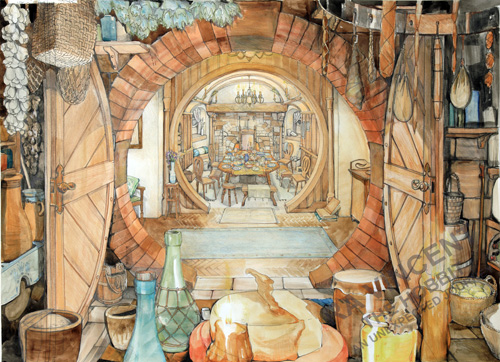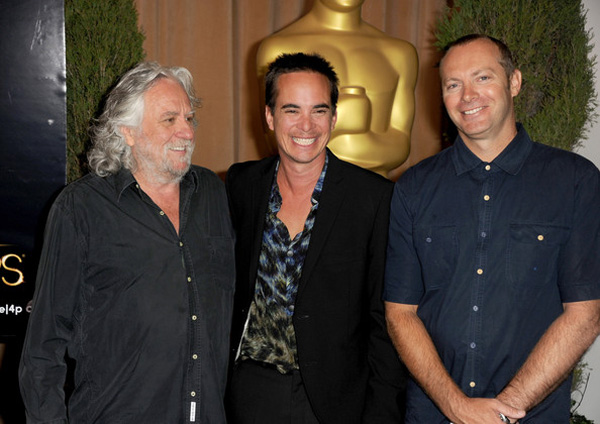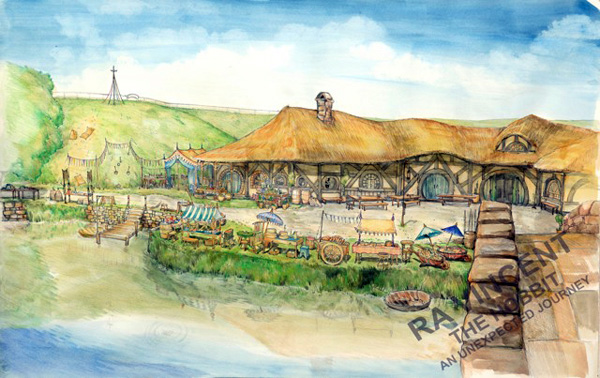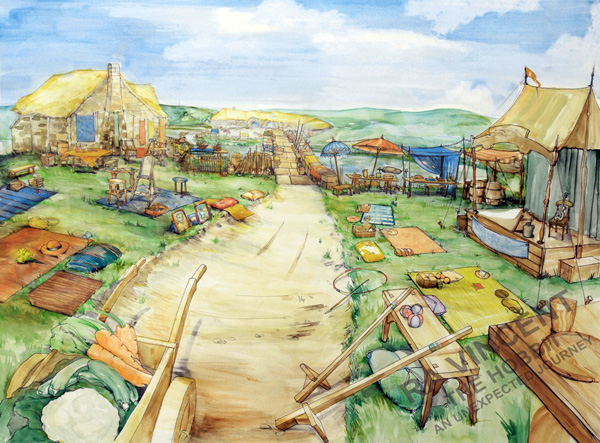The Unexpected Journey: An Interview with
“The Hobbit” Set Decorator, Ra Vincent
Rujuta Paradkar

His first name resembles that of an Egyptian god. His work is ethereal, if not divine. And yes, like a god, he also creates worlds.
Meet Ra Vincent, a New Zealand based artist who sculpts, paints, and works as an art director and set decorator for Hollywood films.
When set designer, Dan Hennah, asked him to collaborate on the set decoration of “The Hobbit,” the power of the ring was too good to be passed on. Having already worked as a sculptor on “The Lord of the Rings” trilogy, Ra re-embarked on an unexpected journey, like Bilbo Baggins himself. Ra’s mission was to expand upon the original trilogy’s interpretation of J.R.R. Tolkien’s middle-earth. For his efforts, he—along with team members Dan Hennah and Simon Bright—was nominated for the Academy Award for Production Design. Ra Vincent’s work will also be seen in “The Hobbit: The Desolation of Smaug,” and “The Hobbit: There and Back Again” (the second and third of the three Hobbit films) slated for release in December 2013 and 2014 respectively.

RUJUTA PARADKAR: You sculpt, paint and work as a set designer. How do you manage so many roles and projects together?
RA VINCENT: Ever since I left art school it has been difficult to settle on a particular subject, so I keep myself creatively fulfilled across as many different medium as any one idea requires, this means often my workshop has multiple projects happening at once. Less chance of getting bored that way.
PARADKAR: Favorite work you’ve done? Why?
VINCENT: My favorite work I’ve done would have to be the latest project I have been involved in. Each job gets more and more interesting as I have always tried to improve myself with each experience. My last project is still under wraps as it has not been released yet, my job was production designer on a New Zealand made feature comedy with directors, Taika Waititi and Jemaine Clement. The chance to work closely with a director and help visualize and then create an environment is very satisfying. Our art department meetings would be held during set painting sessions or a little guitar playing at lunch times.
PARADKAR: How does one start set designing? What excites you about it? How did you discover this passion?
VINCENT: My role has been more about set decoration and production design more recently. Although there is an element of set design in both of these roles they are more involved. Set decoration takes into consideration the color, breakdown, furnishings, and character of an environment sometimes suggesting additions to set designs and is ultimately responsible for the finished item. Production design often concerns itself with the whole visual aesthetic of a film, conceiving set design and filming environments and instructing art directors and decorators to fulfill these ideas on time and on budget.
I have been lucky enough to have worked closely with production designer Dan Hennah. I have worked with him as a sculpting supervisor, art director, and set decorator. My father was a sculptor and, from an early age, I learnt a lot about film set construction and scenic painting.
PARADKAR: Could you share a story of your experience working for Dan Hennah? Something that captures your relationship with him perhaps.
VINCENT: I had traveled to London in 2001 with Dan and a small art department team to dress a party for the release of the “Two Towers.” We worked flat out over the three weeks we where there, building cave trolls and the interior of the Green Dragon. In the final few days, Dan proposed we build a four meter tall ring wraith on a horse … as impossible as it seemed to achieve, our team had no doubt and threw themselves into the task, achieving an amazing build just moments before the catering teams arrived.
The wonderful thing about working with Dan is he trusts his team to produce the goods and allows each department to use the skills they’ve been employed for, while guiding them with magic results.
The environments for the “Lord of the Rings” as with “The Hobbit,” were huge, it was as if we were … creating the world of Middle earth. They were 360-degree fully immersive environments, … pivotal to the actors’ experience…. –R. A. Vincent
PARADKAR: What was your experience like working for “The Lord of the Rings” and “The Hobbit”? Was it both sculpting and scenic work?
VINCENT: “Lord of the Rings” was a very hands on experience for me, it was a great place to learn new skills and improve on ones you thought were at their best. For me, it was four years of intense full time work, which is rare in the film industry. We had enough practice at our craft to become an amazing art department.
“The Hobbit” has also been a great learning ground for me, although this time I have been more involved with design and budgets.
The environments for the “Lord of the Rings” as with “The Hobbit,” were huge, it was as if we were—and in some ways we were—creating the world of Middle earth. Every set piece was epic. They were 360-degree fully immersive environments, this I think was pivotal to the actors’ experience, as they often expressed their excitement for each new set.
PARADKAR: Do you use a pre-visualization technique or any other methods?
VINCENT: The director uses a pre-vis method for working out camera shots and character actions. This looks a little like a rough animated drawing.
For me as a set decorator, I use a series of watercolor paintings to convey color treatment, style of furnishings, and to suggest positions on-set for the various props and dressing.
PARADKAR: What is the magic ingredient that transforms a set into an authentic place that seems realistic or fantastical, and sometimes both at the same time?

VINCENT: I would have to say, the act of dressing an environment as though you were the occupant makes all of the difference. It’s a little like method acting in that you sink into the character that you are portraying. Sometimes making lunch in the kitchen of a house you are dressing or finding places to put away objects that you have no space for.
PARADKAR: You sculpted a nine meter tall Gandalf for the premier of “The Hobbit” in Wellington, NZ. And we heard you did it in just two weeks! Is that true?
VINCENT: It was a two-week sculpt with two of my sculpting buddies, Sam Genet and Masa Ohashi. The surfacing and paint took a third week. Everybody works so well as a team now that we can turn around huge projects very quickly.
PARADKAR: Tell us about teamwork while sculpting this piece?
VINCENT: The process is often very fluid, we started sculpting even before the plans where finalized, sometimes the timeframe needs us to be a little flexible. This resulted in the armature being constructed at the same time as the sculpture was carved. The huge guy was then hollowed out and the steel installed.
PARADKAR: Has technology made an artist’s job easier or more challenging? For example: how do you manage physical set design along with CG elements?
VINCENT: The computer-generated world is nearly always the deep far off background. We try in most cases to build entire sets, so that you’re convinced that you are in that realm totally. This helps not only the actors’ experience, but the crew also has a sense of the tone of the moment they are trying to capture.
PARADKAR: Can you give us an example of this from the “The Hobbit” or “Lord of the Rings”?
VINCENT: The Goblin tunnels from “The Hobbit” are a good example of this. We constructed tunnels and cliffs about two meters off the studio floor. These where then extended digitally to become infinity deep and tall.

PARADKAR: It would seem that working on “The Hobbit” would be difficult, since viewers will have strong opinions on how the world should look from reading the books and seeing the previous trilogy. How do you balance expectations with creative process?
VINCENT: Fortunately, “The Hobbit” spends a few moments in familiar places—Hobbiton, Rivendell—before it ventures off into brand new places. Even though we may recognize some of the places we visited in the Rings Trilogy, we get an opportunity to explore new parts.
It has been great for continuity purposes to have Tolkien artists Alan Lee and John Howe to help visualize some of the new environments in the script.
PARADKAR: How was designing Hobbiton this time around a different experience?
VINCENT: This time we gave Hobbiton a fresher, younger feel. I chose warmer brighter colors for these scenes, much of which was achieved with fabric placed in strategic positions to help frame focal points around the ten-acre site.
PARADKAR: What were some of the challenges you faced while working on “The Hobbit?” Was there a complicated piece(s) you created?
VINCENT: The only real challenge I would say would have been the extremely fast set turn arounds. We would often be removing a mountainside from the studio and replacing it with a forest over night for shooting in the morning.
One example of the set turn around was a landscape (to come in the next film) into part of the Goblin tunnels.
PARADKAR: What is the next project you will work on?
VINCENT: I am writing to you from the cab of my truck on my way on the ferry back to Wellington to build a brick sculpture to commemorate the excavation of an ancient stream beneath Wellington City.
The good thing about an over active imagination [is] you can be anywhere you want, whenever you want. –R. A. Vincent
PARADKAR: What’s your favorite place on planet earth?
VINCENT: A place in the Able Tasman National Park, NZ. We have a little bach there by the sea, boat access only, no electricity and no cell phone reception. Part of this interview, I’ve answered from there.
PARADKAR: For a moment, I thought you might answer, “Middle-earth.” Isn’t it cool that if your favorite place doesn’t exist you can actually design it?
VINCENT: That I suppose is the good thing about an over active imagination, you can be anywhere you want, whenever you want.
PARADKAR: Any advice or words of wisdom you can offer to aspiring artists?
VINCENT: Enjoy what you do. After all, it is the doing that makes us alive.

Rujuta Paradkar, Executive Editor

0 comments on “Interview: Ra Vincent”